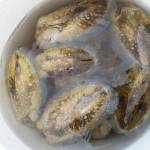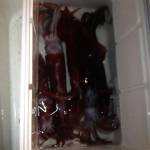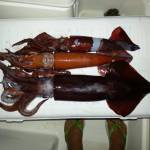FISHING CEPHALOPODS
Fishing calamari and cuttlefish is becoming more and more popular thanks to the research on artificial lures that give good satisfactions.
First of all we have to mark the difference between calamari, cuttlefish and squid.
Calamari’s body (Loligo vulgaris) is extended, with two rhomboidal flippers at the sides of the tapered body that makes them looks like a rounded lance’s tip. Its eyes are on the sides, the two longest tentacles have different dimensions and are partially retractable, while the eight shortest tentacles of different dimensions have regular suckers arranged in two lines.
Of pink colour with red and brown marks, the calamari can reach 10 kg of weight and 1 meter of length.
The squid looks like a calamari but with two shorter triangular flippers, the two long tentacles are not retractable and are equipped with four lines of suckers while the other eight tentacles are the same and long a half. The squid colour is iridescent violet and its weight can vary from 1 to 15 kg while its length is more than one meter.
These cephalopods both live in the depth, in muddy areas but the calamari also likes corals sea bottoms and expanses of posidonia.
The cuttlefish is also a decapods, it has an oval and pressed body equipped with a bone frame in the inside (the well-known “bone of cuttlefish). The two longest tentacles are also larger at the extremities with four lines of suckers; the body’s colour changes from a zebra-striped grey colour to green and brown, because the cuttlefish has mimetic power. It lives in sandy sea bottoms or among rocks and algaes. Its bladder is more developed than the others cephalopods.
Squids, calamari and cuttlefish can be fished both with alive lures and artificial lures, whether in the morning or in the night. The artificial lures vary in the shape, dimension, weight and above all in the colours.
This method is used all year by our guide.



